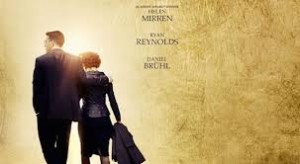Interview: The Woman in Gold’s Simon Curtis and E. Randol Schoenberg
Posted on March 31, 2015 at 3:37 pm
Director Simon Curtis told me, “My last film was My Week with Marilyn, and this one is my century with Maria.” He is referring to “The Woman in Gold,” with Helen Mirren as Maria Altmann, who brought a lawsuit to get back the portrait of her aunt Adele, painted by Gustav Klimt, which had been stolen by the Nazis. The story covers much of the 20th century, from Maria’s childhood in a wealthy Viennese Jewish family, in a luxurious apartment, where the portrait was on the wall. I met with Curtis and Randy Schoenberg, the real-life lawyer who represented Ms. Altmann, who is played by Ryan Reynolds in the film.
It is an extremely complicated story, so I asked Curtis how he decided what he needed to focus on. “It could have been so many different movies. Adele could have been a movie in her own right. We wanted to tell the story of Maria and Randy’s relationship and their campaigns. Once we were telling that story we realized we needed to just go back into the past and get a sense of that incredible time in Vienna before the second World War and in particular that sense of community, that extraordinary community that produced so much that the world benefited from and that was kind of shattered overnight in 1938. I was influenced by the Bergman film Fanny and Alexander and I felt the sense of that apartment where all these people, all the different generations who bumped into each other and thrived on each other.”

Schoenberg, whose grandfather, the composer Arnold Schoenberg, was one of the luminaries who visited Altmann’s family in Vienna, knew Ms. Altmann because their families stayed in touch when they emigrated to the United States. As shown in the film, he was young and inexperienced when she asked him to help her get the painting back. I asked if their relationship was as spirited as the one portrayed in the film. “Sometimes it was,” he said. “Every part of the film where you think, ‘Oh, that must have been made up’ has this core of truth to it. So I told Alexi Kaye Campbell that I had at one time an argument with Maria. It was actually after we won the case but Austria had required us to do a whole procedure where they could have an option to buy the paintings. This was after they decided, and Maria was feeling so magnanimous that they flew out to meet with us. They said, ‘We need more time.’ She was 89 years old. And she said, ‘Oh of course, there is no problem,’ and I pulled her aside and I said, ‘Maria, you cannot do this to me after eight years of working on this. You can’t let them do this. They are going to stall; they are going to find out some way not to give back the pictures and it’s all going to be lost.’ And I had to really sort of fight with her. So that shows up in the film in other ways. We had a very friendly relationship obviously because she was very close with my family, very close with my grandmother and she would tell stories about my grandmother and great grandmother. So normally we had a very friendly relationship like being with my own grandmother.”
As shown in the film, Ronald Lauder (who ultimately bought the portrait) did offer to pay for a more experienced team of lawyers. In real life, Schoenberg urged her to get advice from some independent law firms about whether he was up to the job. After she consulted them, she decided to keep him. And, as shown in the film, he was so nonplussed by the first question he was asked at the Supreme Court that all he could do was say, “I’m sorry, I don’t understand the question.”
This was not the first time Curtis worked with Dame Helen Mirren. He was a production assistant on one of her films, where he said his job was bringing her coffee. “That’s pretty much all I did with her on this film as well,” he laughed.
